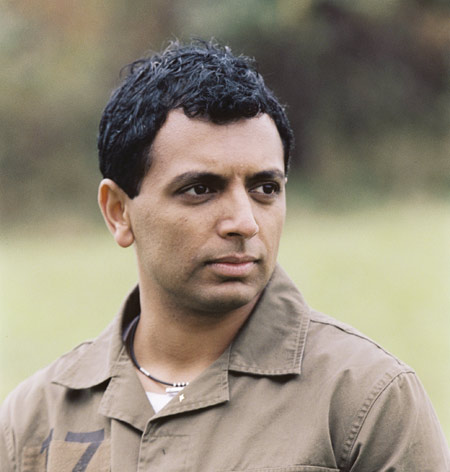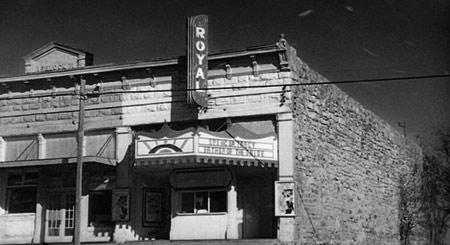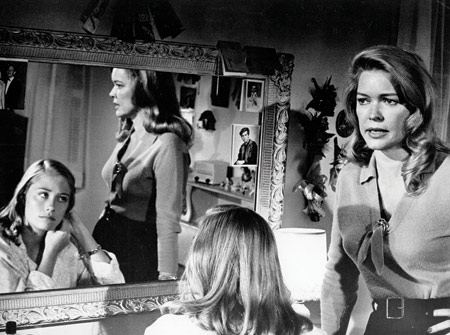BY ROB FELD
 TONE POEM: Shyamalan (above)
TONE POEM: Shyamalan (above)most admired how the film
relies on texture not plot.
"I think Peter Bogdanovich’s mastery of tone in this film is the holy grail of filmmaking,” says M. Night Shyamalan. “I’m voraciously after that as both an audience member and a filmmaker.” We are preparing to watch the Criterion Blu-ray disc created from a fresh 35 mm positive of The Last Picture Show (1971), as Shyamalan takes a seat in the screening room of his converted-barn production offices outside of Philadelphia.
He recalls first encountering Bogdanovich’s film, adapted from Larry McMurtry’s novel set in dying, crumbling Anarene, Texas, in 1951, while in his mid-20s, and finding its sexuality and depiction of small town mores irresistible. The film patiently follows three teenagers, Sonny (Timothy Bottoms), Duane (Jeff Bridges), and Jacy (Cybill Shepherd) through their senior year of high school and beyond, as they move inexorably toward an empty future. “The texture that was caught here; it immediately became one of my favorite movies. It’s one of the great examples of immersive filmmaking.
“I want to make tonal movies [like this], where plot is almost obscene,” continues Shyamalan as the lights go down. “In fact, I think I get in trouble because my movies are presented as plot driven vehicles, so I’m perceived more for that characteristic when in reality my tastes are more here, more like Kubrick and [Antonioni’s] Blow-Up.”

ALL ALONE: The atmospheric black and white fades in on Anarene’s lone movie theater; wind and tumbleweeds blow through the dirt main street.
The atmospheric black and white fades in on Anarene’s lone movie theater; wind and tumbleweeds blow through the dirt main street. The camera pans lazily to catch Sonny’s truck, chugging and backfiring in the distance, before cutting sharply to Sonny’s fingers on the choke and foot pumping the gas. “The idea of a long, slow, wide shot that suddenly cuts to jagged close-ups is unorthodox and arresting because you’re set up for methodical pacing,” says Shyamalan.
“This notifies you that the film is not going to be told in one language. It’s zero-to-sixty filmmaking: there’s no medium [speed], it’s quiet then violent. The shot tells you that unexpected, borderline shocking things will occur in the movie, which they do. It foreshadows unsentimental storytelling.”
Hank Williams’ wails of sexual frustration come from Sonny’s radio, and music playing like this will provide the movie’s only soundtrack. “The [use of] source music as movie score is fantastic to add texture and reality to the film, as if it’s a documentary,” says Shyamalan, as Sonny’s mute sidekick, Billy (Sam Bottoms), pointlessly sweeps the dirt road with a broom and then stops and hops in the truck. “It gives everything authenticity. And no BS dialogue when he got into the truck; Sonny turns Billy’s cap around; done. Nothing overdone. That tells you something.”
The boys meander to the pool hall, owned by Sam the Lion (Ben Johnson), a father figure to all. Here, Bogdanovich starts building a sense of community, as Sonny gets a ribbing for his football team’s loss the night before.
“The art direction of the pool hall, like everything else in the movie, is minimal and sparse. It lets you feel the loneliness of the place. And this subtle shot here,” Shyamalan says, pointing as the camera angles up to catch Sam’s expression when Billy exits in the background, “is almost like a suspense movie. There are so many dynamics at work; you’re leaning in to try to understand them all. And Sonny’s shrug as he’s teased is such a great, idiosyncratic response,” he continues, speaking of the non-verbal performances Bogdanovich encourages. “It takes the film away from stiff, intended acting.”
Sonny moves on, joining Duane on a walk through town, taking more guff over the game from a string of well-drawn locals. “When you get the bit characters right, you’re talking about filmmaking where tone is the most important thing.” As one last football fan stands over their coffee shop booth with only a “tisk” before moving on, Shyamalan cackles with laughter. “Bogdanovich doesn’t feel the need to catch you up on everything. It’s as if you’re dropped into this town. The god of this movie is tone. Why be constrained by telling us who that guy is?”
Sonny proceeds to the picture show to meet his less than inspiring, gum-chewing girlfriend, Charlene (Sharon Taggart), and makes a half-hearted attempt at necking in the back. They are soon followed by Duane and Jacy, who Bogdanovich introduces with a movie star close-up that stops Sonny’s breath. Jacy’s face is half lit by the reflection from the movie screen on which another beauty is mirrored, Elizabeth Taylor.
“Literally breaks your heart!” exclaims Shyamalan, observing how Bogdanovich has physicalized the experience. “To intro a character like that, right into the camera, uncomfortably close, is masterful direction. And he keeps cutting to the gum-chewing girl, so unattractive. Sonny’s in his normal life and this angel enters, fills his entire frame and says, ‘hi.’ And you’re in shock because stuff like that doesn’t happen. It’s beautiful how Bogdanovich relates her to the movie show and what life is like outside of the small town. As Jacy struggles to get out of town, she even thinks of her life like the movies, something bigger than Anarene. But Bogdanovich doesn’t manipulate you with close-ups; he lets you find things. He frequently has characters in the foreground and others in the deep background, as in the pool hall, which makes you notice the place.”
JOY RIDE: As Timothy Bottoms, Jeff Bridges and Cybill Shepherd move aimlessly through their lives, the town’s sexual currents bubble up.
Shyamalan stops watching for a moment and laughs, recalling how he recycled the kissing scene between Sonny and Charlene in Signs (2002) when Joaquin Phoenix tells a story about spitting out his gum before kissing a girl who almost vomits on him. “You know, it’s funny, I see a bunch of stuff from Signs in here that I must have ripped off. I also did a thing with a dolly shot where it seems like it stops and the shot is done, then it’s not. I loved that. I’m such a thief!”
Turning back to the action, the kids disperse into the night to make out in their trucks. Sonny is dispassionate and bored as Charlene disrobes as if she were changing for a track meet. “The cavalier way she rips off her bra, the sterile way he holds her breast; it’s all happened before. Real life is heartbreakingly funny,” says Shyamalan, shaking his head in recognition. “The ennui that settles in a small town is so palpable, and violently fought against by the sexuality. I have to believe they shot on location; it’s so textured and specific, but doesn’t draw attention to itself.”
Returning home, the angst-ridden Jacy brushes her hair in a bedroom as affluent and composed as Anarene is ramshackle. Her mother, Lois (Ellen Burstyn), who was clearly as beautiful as Jacy in her day, urges her to go out and demystify sex before she makes a mistake and marries Duane. Bogdanovich blocks the two women jousting verbally in the vanity mirror.
“Bogdanovich’s use of the mirror is fantastic. I love seeing close-ups and backs of heads in the same shot, getting two versions of everything,” explains Shyamalan. “They never actually look at each other. Lois watches her daughter, then starts fixing herself up, too, which says a lot about where they are in their lives: Lois was once this same high school girl, or still even sees herself that way. Jacy is looking up to her mom, and Lois is looking down at the daughter. It’s excellent filmmaking,” he says, laughing as Jacy shoves her cat off her bed in frustration. “There, again, dialogue by action.”
Meanwhile, Bogdanovich picks up another story thread. With graduation approaching and no plans to speak of, Sonny does a fateful favor for his football coach and escorts his wife Ruth (Cloris Leachman) to the doctor. Shyamalan responds to Leachman’s performance as she invites Sonny into her kitchen and her casual smile brightens the neglected woman for the first time. “She does that so well. It’s attractive,” he says, again focusing on Bogdanovich’s use of art direction to drop the audience into the middle of these lives. “I love the mess on the table, not put away. Then her expression as she watches him leave also says so much; rather than cutting to Sonny, Bogdanovich stays on her, which gives such depth to her character. He honors every person in the movie, and doesn’t conform to the hierarchy of cutting to the lead.”
It doesn’t take long for Jacy to heed her mother’s advice and start to look beyond Duane. In his truck at the Christmas dance, she prepares to ditch him for a pool party with the country club kids. She manipulates his objections with an embrace, her face over his shoulder half covered in shadow. She briefly guides his hand up her dress for the first time. Her eyes are calculating a mile a minute, while Duane’s face goes stark dumb.
“I mean, that’s comedy. Two different conversations are going on. Duane can’t even think!” exclaims Shyamalan, cringing in his seat as Jacy pushes Duane away. “That was horrific. It’s amazing how the lighting brings forth her split personality and shows what she’s capable of. It’s a throwback to film noir and makes her character a monstrosity. This is one of the few places Bogdanovich does that.”

MIRROR IMAGE: Jacy’s mother (Ellen Burstyn) sees her reflection in her daughter. Shyamalan loves how Bogdanovich shows a close-up and the back of their heads in the same shot.
Anarene’s sexual undercurrent continues bubbling up as Sonny and Ruth find themselves emptying trash outside the dance. Bogdanovich’s camera angles up at the couple, only rising to eye level as they kiss.
“Incredible,” says Shyamalan. “Over garbage! This is the way life unfolds. I love the uncomfortable sexuality of the characters. The camera shows you how an ordinary moment becomes unexpectedly intimate when they simultaneously realize, ‘Oh, my god, I’m standing out here in the dark and you and I are almost touching cheeks.’ When they glance at each other, acknowledging it, and the camera comes up, it’s startling, vulnerable and revelatory.”
At the pool party, Jacy goes through a rite of passage, awkwardly removing each of her 1950s undergarments on the diving board. “I remember I was not prepared for this scene,” Shyamalan recalls, “even though Bogdanovich had hinted at the sexuality already. The belly of this small town has a veneer of easiness and conservatism, so it’s shocking.”
The shot holds on Jacy and all goes silent except for the quiet lapping of water in the pool. “The sound effects of the water are like everybody’s heartbeats, and the lust emerging from the audience. And then the water sounds stop.” Shyamalan narrates as she gets to her bra hooks. “The sound design scares me in how awkward it is. Her heart would be beating so fast, coming into a place where she has to prove herself sexually, and then everyone becomes silent. That’s what it would feel like: you would hear every movement, and all you’d feel are eyes on you as you undress. It’s a fantastic use of sound.”
After the host of the party rejects Jacy because she’s still a virgin, she uses Duane to remedy that state of affairs, then kicks him to the curb. But the rich kid marries another girl anyway and when an older manÑher mother’s loverÑuses and discards her, Jacy takes out her frustration by seducing Sonny, who eagerly complies despite his friend’s broken heart and his ongoing affair with Ruth. “All these things collide here,” says Shyamalan. “The purity of the small town represented by Sonny, his betrayal of Ruth, their rebellion against their lives, and Jacy’s need to feel anything, even if it’s pain.”
Duane confronts Sonny and when a scuffle ends with Sonny taking a beer bottle to the eye, Bogdanovich explosively pays off the tension he’s built. “Look at all these severe angles and extreme close-ups with lens distortion,” says Shyamalan, describing the quick cuts and shaky camerawork used to capture the fight. “It’s so sharp, and so quiet and shocking without a score. It’s like the beginning of the movie with the wide shot, then close-ups on Sonny’s boot and the ignition. Beautiful extremes. Bogdanovich punctures all the sedateness of the small town with sexuality and violence, and these violent cuts.
BAD NEWS: Bottoms and the coach’s wife (Cloris Leachman) in a quiet, tragic moment. Bogdanovich often uses just looks and expressions instead of dialogue.
“What’s fascinating about the film is that you can’t tell where you are in it,” Shyamalan continues, taking a broad view once the fight ends. “If somebody came in now, they couldn’t tell. It’s unusual. The plots come and go irrelevantly as side affairs, and little storylines pop up; Jacy manipulating Sonny to get married, or going to the pool party. It feels like plot, so you’re thinking, ‘Oh, our two main characters are finally getting together,’ but then it doesn’t lead anywhere. It’s all textural.”
Jacy makes quick work of Sonny, who had jilted Ruth after finding months of comfort in her arms. But when Billy is killed by a truck while sweeping the street, Sonny has nowhere to turn and runs to Ruth for solace. When she opens the door, her hair is a mess and she’s still in her robe. A laugh track emanates from her television, punctuating the rejection she’s felt. Bogdanovich pushes in with the sort of camera move he rarely makes.
“Bogdanovich does so much of his dialogue with just looks and expressions, and then Ruth has this monologue. She gets to do the full arc of the conversation because Sonny isn’t answering her. She goes from anger to the next phase of mourning, bitterness, and then forgiveness.” Shyamalan follows the change as Leachman goes quiet and her face travels through miles of emotional terrain, finally seeing Sonny for the lost boy he is. Fixing his collar she says, “Never you mind, honey. Never you mind.”
“It isn’t indulgent,” says Shyamalan. “It’s just naked in the very best way. Any more words would’ve spoiled it.” He pauses to consider what Bogdanovich has accomplished. “I love just sitting in a moment, but I know that hurts plot. You lose momentum. So to see a movie that relies solely on tone, and relegates plot to its rightful place in the second position, is thrilling.”
How then did Bogdanovich maintain his momentum with so little plot? “I guess the answer is in how he tells the story,” says Shyamalan. “He uses the pyrotechnics of sexuality, for sure. He has the nuance, the idiosyncrasy, and we fall in love with it. If you live the life during these two hours, you are rewarded for being patient and accepting. The difference between anticipating and accepting allows a filmmaker to do a lot."